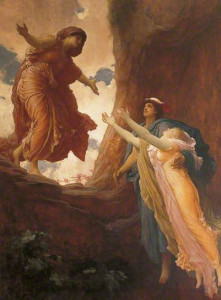
The Return of Persephone (c. 1891), by Frederic Leighton (1830–1896). Leeds Art Gallery, Leeds Museums and Galleries.
Persephone is a Greek goddess and Queen of the Underworld in Greek Mythology. She is the daughter of Zeus (King of the Gods) and Demeter (Goddess of the harvest). Her story was used in ancient Greek culture to explain seasons. She was abducted by Hades (King of the Underworld) and this loss caused her mother to neglect the earth, causing a drought where all crops died, and the ground became hard and infertile. This caused starvation among the people and finally Zeus tried to help Demeter get her daughter back, by trying to force Hades to return Persephone. However it was too late; Hades had tricked Persephone into eating some pomegranate seeds (stories differ between four and six seeds) and whoever eats in the underworld is bound to stay there for eternity. These seeds bound Persephone to the underworld for four (or six) months of the year.
During the four months of the year where Persephone is with Hades, and away from her mother, Demeter grieves and no longer cares from the earth. This matches the Greek Mediterranean weather, where during the hot summer months the land is dry and it is difficult to grow anything. The cult of Persephone and Demeter is believed to have derived from an older agrarian cult, due to their association with the harvest and seasons.
In Roman mythology Persephone, is known as Proserpina, and her mother Ceres.
-Danielle Triggs
Junior Girl
Girl Museum Inc.
